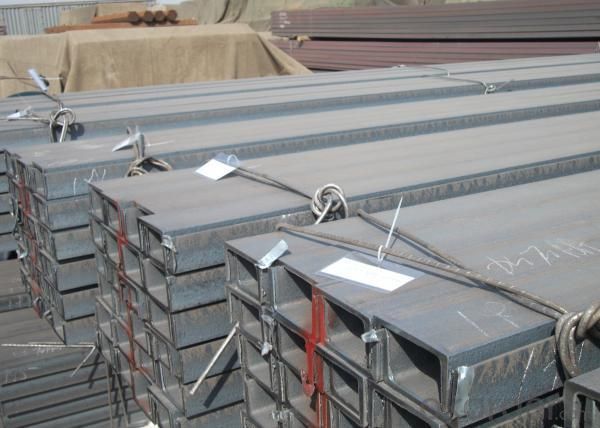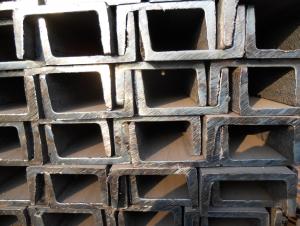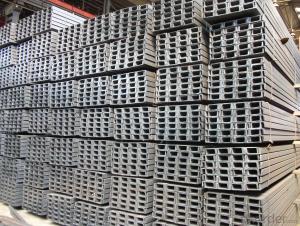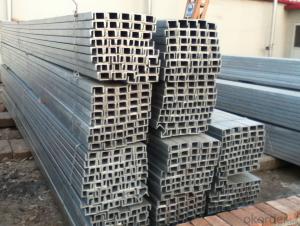Channel Steel UPN
- Loading Port:
- Xingang Port
- Payment Terms:
- TT or LC
- Min Order Qty:
- 25 m.t.
- Supply Capability:
- 80000-100000MTS/YEAR m.t./month
OKorder Service Pledge
OKorder Financial Service
You Might Also Like
Specifications of UPN Channel Steel:
1.Our UPN Channel Steel has lots of advantages, just as followings:
a) At reasonable price and good quality.
b) To be convenient in construction and to save much time and labor.
c) The length of UPN can be manufactured according to customer’s requirements.
d) The UPN Channel Steel has strong mechanical strength.
e). The UPN Channel Steel possesses various kind of fittings, through which it is suitbal for many combinations.
f) Our UPN Channel Steel is attractive in appearance as well as beautiful in design
g) Free from slotted punching
2. The detailed sections of our UPN Channel Steel can be found in table-1
|
UPN U CHANNEL |
Standard h |
Sectional b |
Dimension s |
t |
Mass: Kg/m |
|
|
(mm) |
(mm) |
(mm) |
(mm) |
|
|
80x45 |
80 |
45 |
6.0 |
8.0 |
8.64 |
|
100X50 |
100 |
50 |
6.0 |
8.5 |
10.6 |
|
120x55 |
120 |
55 |
7.0 |
9.0 |
13.4 |
|
140x60 |
140 |
50 |
7.0 |
10.0 |
16.0 |
|
160x65 |
160 |
65 |
7.5 |
10.0 |
18.8 |
|
180x70 |
180 |
70 |
8.0 |
11.0 |
22.0 |
Table-1
Note: we are definitely good at manufacturing and supplying UPN channel steel as per S235JR. Also, we are willing and able to provide our customers UPN channel steel in other sizes, which depends on customers’ concret requirements for the quantity.
3. The chemical composition of UPN Channel Steel as per S235JR is shown in the table-2
|
Alloy No |
Element(%) | ||||
|
C |
Mn |
S |
P |
Si | |
|
S235JR |
0.12—0.20 |
0.3—0.7 |
≤0.030 |
≤0.030 |
≤0.20 |
Table-2
4. The mechanical property of UPN Channel Steel as per S235JR is shown in the table-3-1 and table-3-2
|
Alloy No |
Yielding strength point( Mpa) | |||
|
Thickness (mm) | ||||
|
≤16 |
>16--40 |
>40--60 |
>60--100 | |
|
≥ | ||||
|
S235JR |
235 |
225 |
215 |
195 |
Table-3-1
|
Alloy No |
Tensile strength (Mpa) |
Elongation after fracture(%) | |||
|
Thickness (mm) | |||||
|
|
≤16 |
>16--40 |
>40--60 |
>60--100 | |
|
≥ | |||||
|
S235JR |
340--510 |
24 |
23 |
22 |
27 |
Table-3-2
Applications of UPN Channel Steel:
The UPN Channel Steel can be applied to construction of warehouses, workshops, sport stadiums and car parks etc.The hot rolled channel steel belongs to carbon structural steel which is applied to in the field of construction and machinery.In details, the hot rolled channel steel is usually used for arch-itechtural structure, and they could be welded in order to support or hang a vari-ety of facilities. They are also usually used in combination with I beam. Generally,the hot rolled channel steel we supply must possess perfect welding property, riveting property and mechanical property and so on.
Package & Delivery of UPN Channel Steel:
1.The channel steel will be packed in bundle with steel wire at each end of every bundle and color marking in order to help the customer to recognize his goods more easily at sight.
2. And the channel steel could be loaded into 20ft or 40ft container, or by bulk cargo.If the weight of each bundle reaches more than 3.5 mt, the loading by break bulk cargo should be choosed.When the weight of each bundle reaches less than 3mt, the loading by container should be choosed.
3.As for the transportaion from mill to loading port, the truck will be usually used. And the maximum quantity for each truck is 40mt.
4.All in all, we could do in accordance with customer's request.
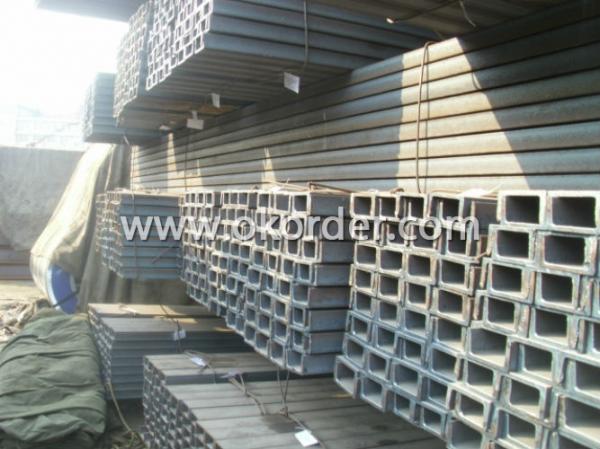
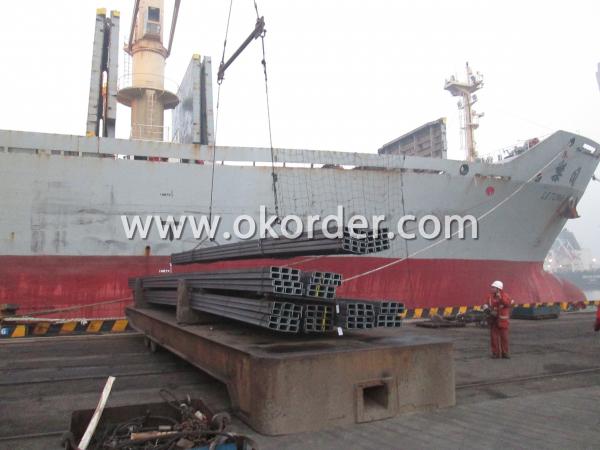
Production Flow of Steel U Channel:
1.The steel billet shall be heated in the high temperature furnace.
2. The heated steel billet shall be rolled five to nine times with the aim of shaping the general figure of steel u channel.
3. The rolled steel u channel should be put onto the cooling bed to make the temperature low.
4. The steel u channel should be straighted on the straightener.
5. The straighted steel u channel will be cut into meters by saw, as per customer's requirements.
6. At the last part of production, the channel steel must be tested in order to confirm that the finished products are completely free from crack, pore, slag, scab or fold on the surface.
- Q:What are the applications of steel channels in construction?
- Due to their strength, durability, and versatility, steel channels are widely used in construction for a variety of purposes. The following are some key applications of steel channels in construction: 1. Structural Support: Steel channels are commonly employed to provide structural support in buildings, bridges, and other infrastructure projects. They can be utilized as beams or columns to effectively carry loads and distribute weight. 2. Framing: Steel channels are frequently utilized in framing applications, particularly for walls, ceilings, and roofs. They offer a robust and dependable framework that ensures the stability and integrity of the structure. 3. Staircases and Handrails: Steel channels are an ideal choice for constructing staircases and handrails due to their strength and rigidity. They provide a safe and durable solution, especially in areas with high foot traffic. 4. Reinforcement: Steel channels can be used to reinforce concrete structures, such as foundations, walls, and slabs. By incorporating steel channels, the strength and load-bearing capacity of the concrete are significantly enhanced. 5. Mezzanine Floors: Steel channels are commonly used to create mezzanine floors, which provide additional space in buildings without the need to expand the footprint. Steel channels offer a lightweight yet sturdy solution for supporting the floor structure. 6. Industrial Racks and Shelves: Steel channels are extensively used in the construction of industrial racks and shelves. Their ability to bear heavy loads and their durability make them suitable for storing heavy equipment, materials, and products. 7. Infrastructure Projects: Steel channels find widespread applications in large-scale infrastructure projects, including bridges, tunnels, and railways. Their high strength-to-weight ratio makes them ideal for withstanding heavy loads and resisting environmental factors. 8. Architectural Design: Steel channels are commonly employed in architectural design to create unique and aesthetically pleasing structures. They can be shaped and welded into various configurations, allowing architects to bring their creative visions to life. Overall, steel channels are of utmost importance in the construction industry, providing a dependable, durable, and versatile solution for various applications. Their strength, load-bearing capacity, and flexibility make them indispensable in modern construction projects.
- Q:Are steel channels suitable for corrosive environments?
- Steel channels can be suitable for corrosive environments, depending on the specific conditions and the type of steel used. Stainless steel channels, for example, are highly resistant to corrosion due to their high chromium content. They can withstand exposure to moisture, chemicals, and other corrosive agents without deteriorating. However, carbon steel channels may not be as suitable for corrosive environments, as they are more vulnerable to rust and corrosion. In such cases, additional protective measures such as coatings or galvanization may be necessary to prevent corrosion. Ultimately, the suitability of steel channels for corrosive environments will depend on the specific application and the type of steel chosen. It is important to consult with experts or engineers to determine the best material for a particular corrosive environment.
- Q:Can steel channels be used in telecommunications towers?
- Steel channels are indeed applicable in telecommunications towers. Their strength, durability, and versatility enable a range of uses. In terms of structural support, steel channels provide stability and the ability to bear heavy loads for the tower. By fabricating and assembling the channels, they form the framework of the tower, allowing for the installation of diverse equipment like antennas, transmitters, and receivers. Moreover, the design of steel channels allows for seamless integration of cables and wiring, thereby facilitating efficient connectivity throughout the tower. Ultimately, the incorporation of steel channels in telecommunications towers guarantees a robust and dependable infrastructure for effective communication networks.
- Q:Channel 20A? What's the matter?
- Channel steel, 20#A specification, 200*73*7.0 theory, weight 22.637
- Q:Can steel channels be used for roof truss systems?
- Roof truss systems can indeed utilize steel channels. These channels, also referred to as C-channels or U-channels, are widely employed in construction due to their robustness and durability. They can be shaped and sized to fit various requirements, making them suitable for a range of applications, including roof truss systems. Steel channels offer exceptional structural support, making them well-suited for carrying the weight of a roof and evenly distributing it across the truss system. Moreover, steel channels boast a high resistance to corrosion, which is vital for enduring the elements and ensuring the long lifespan of the roof truss system. All in all, steel channels present a dependable and effective option for the construction of roof truss systems.
- Q:In the steel structure of steel purlin 160*60*20*2.5 is what mean
- The horizontal component roof length distribution, located in the main rafters, support secondary rafters. The ancient houses used to stir up the rafters, roof bars made of, is one of the main components of the house, also called the boat (or sub truss northern dialect).
- Q:8# what's the size of the channel steel?
- Channel steel is a kind of carbon structural steel used for construction and machinery. It is a complex section steel. Its cross section has a groove shape. Channel steel is mainly used in building structure, curtain wall engineering, mechanical equipment and vehicle manufacturing, etc.. In use, it requires better welding, riveting performance and comprehensive mechanical properties. The raw material steel billet for channel steel is carbon or low alloy steel billets with a carbon content of not more than 0.25%. The finished channel steel is delivered by hot forming, normalizing or hot rolling. The specifications are expressed in millimeters of height (H) * leg width (b) * waist thickness (d), such as 100*48*5.3, which means waist height is 100 mm, leg width is 48 mm, waist thickness is 5.3 mm channel, or 10# channel steel. The same height of the channel, if there are several different leg width and waist thickness, also need to add a, B, C on the right side of the model to distinguish, such as 25#a, 25#b, 25#c and so on.
- Q:What are the different types of bracing for steel channels?
- Steel channels offer a variety of bracing options to meet specific project requirements and structural designs. The following are some common bracing types for steel channels: 1. Lateral Bracing: To prevent buckling or twisting under lateral loads, cross-bracing involves connecting diagonal members between the channels for stability. Another option is perpendicular bracing attached to the channels. 2. Diagonal Bracing: This involves connecting diagonal members between steel channels to resist horizontal forces and provide stability. Diagonal bracing is typically used in trusses and frames to withstand wind and seismic loads. 3. Tension Bracing: Tension bracing resists tensile forces in steel channels. This can be achieved by connecting tension rods or cables to the channels. Tension bracing is commonly used for additional support and stability in structures with long spans or heavy loads. 4. Compression Bracing: Compression bracing uses compression members attached to steel channels to resist compressive forces. This type of bracing is often used for added support and stability in structures with high vertical loads or susceptible to buckling. 5. Shear Bracing: Shear bracing resists shear forces in steel channels. This can be achieved by connecting shear plates or angles to the channels. Shear bracing is commonly found in structures subjected to lateral loads or high shear forces, such as bridges. It's important to consider factors like structural design, load requirements, and building codes when selecting the appropriate bracing option for steel channels. Consulting with a structural engineer or a professional experienced in steel construction is recommended for determining the most suitable bracing option for a specific project.
- Q:How do steel channels perform under vibration?
- Steel channels generally perform well under vibration due to their high stiffness and strength properties. They have the ability to resist and dampen vibrations, making them suitable for various applications where stability and durability are required. The inherent rigidity of steel channels helps minimize unwanted movement and maintain structural integrity, ensuring reliable performance even in high-vibration environments.
- Q:How to judge whether the joint of steel structure is rigid or hinged, as shown below, the steel beam and steel column are all channel steel and welded through weld joint.
- I don't think we can generalize. The connection of the steel structure is mainly welding seam connection and bolt connection; generally speaking, the welding seam is just connected, but the bolt is not necessarily. The bolt section, there are friction; if the friction force of the bolt section is far greater than the moment, so it can be identified as rigid; if the two force magnitude close, then identified as articulated, and to check the moment.
1. Manufacturer Overview |
|
|---|---|
| Location | Tangshan, China |
| Year Established | 2000 |
| Annual Output Value | Above US$ 50 Million |
| Main Markets | Mid East; Southeast Asia; Korea |
| Company Certifications | |
2. Manufacturer Certificates |
|
|---|---|
| a) Certification Name | |
| Range | |
| Reference | |
| Validity Period | |
3. Manufacturer Capability |
|
|---|---|
| a)Trade Capacity | |
| Nearest Port | Tianjin |
| Export Percentage | 20% - 30% |
| No.of Employees in Trade Department | 10-20 People |
| Language Spoken: | English; Chinese |
| b)Factory Information | |
| Factory Size: | Above 81,000 square meters |
| No. of Production Lines | 1 |
| Contract Manufacturing | OEM Service Offered |
| Product Price Range | Average |
Send your message to us
Channel Steel UPN
- Loading Port:
- Xingang Port
- Payment Terms:
- TT or LC
- Min Order Qty:
- 25 m.t.
- Supply Capability:
- 80000-100000MTS/YEAR m.t./month
OKorder Service Pledge
OKorder Financial Service
Similar products
New products
Hot products
Hot Searches
Related keywords





